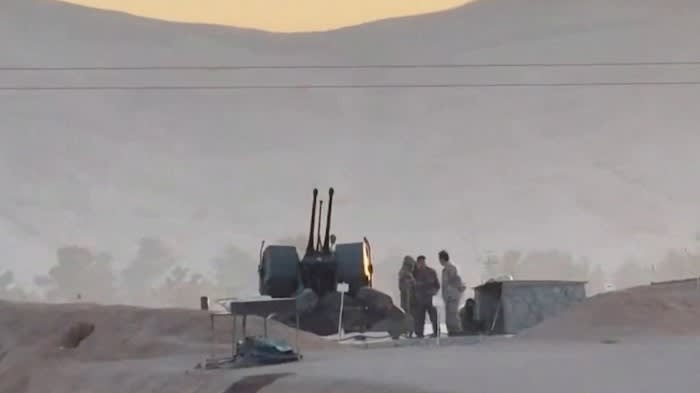Mysterious wreckages photographed in Iraq have given the clearest indication yet of how Israel might have launched its counterstrike against Iran.
The pictures, scoured by military analysts and open-source intelligence enthusiasts, suggest that Israel may have used an air-launched Sparrow ballistic missile to demonstrate to Tehran that it can successfully attack targets inside the country at range.
One Israeli official also indicated that the country’s armed forces used a stand-off missile attack launched far from Iran’s borders. “Israel has informed its partners that the primary attack vectors were airborne, with no entry into (Iranian) airspace,” the official said.
The exact combination of arms used in the counterstrike remains unclear, but it comes a week after Iran launched an unprecedented drone and missile salvo at Israel, itself a response to a suspected Israeli strike against Iran’s consulate in Damascus.
The missile segments, photographed and posted on social media by Sabereen News, an outlet linked to Iraqi Shia militias, were identified by some experts as most likely being the expended fuel propulsion units of Israeli-made Blue Sparrow missiles. Early Pentagon assessments pointed in the same direction, according to one person briefed on the work.
The Sparrow family of air-launched missiles have a range of up to 2,000km and could have been fired by Israeli fighter jets refuelled by tanker planes in Syrian airspace, according to OSINT analysts citing air flight data from late on Thursday.
Buttressing that theory, Syria’s Sana state news agency reported that Israeli missiles had targeted air defence positions in its southern region. Such a move would fit with Israel “clearing the air corridor in Syria for a stand-off strike on Iran”, said one former senior US defence official.
Opening a safe air raid corridor in Syria would in turn enable long-range attacks by Israeli fighter jets well outside Iranian airspace. As the Israeli missiles then flew east over Iraq, they would have jettisoned their fuel booster units, with the armed sections carrying on to their targets in Iran.
Israel has not commented on the strike, as per its traditional policy of strategic ambiguity. The US has said it played no role. The International Atomic Energy Agency also said none of Iran’s nuclear sites were damaged.

Iran has meanwhile downplayed what happened, with officials signalling there are no plans to respond. One Iranian official told the Financial Times that a limited number of missiles were part of the attack but said they were intercepted.
“There is a lot of uncertainty still,” said John Ridge, an OSINT analyst. “But Sparrow missiles most closely fit the mission parameters . . .[especially] of range.”
Sparrow missiles have three variants: the short-range Black Arrow, and the mid-range Blue and Silver Arrow versions. Blue Sparrow missiles have “performed flawlessly in its missions so far”, according to its producer, Israeli defence company Rafael.
Ridge added that another possible weapon used by Israel may have been Rocks missiles, an air-launched precision missile similar to the Sparrow. Both are made by Israeli defence tech group Rafael.
Initial reports from Iranian state media suggested that Israel may have also used small drones or quadcopters rather than missiles for the attack. Iranian foreign minister Hossein Amirabdollahian said the “mini drones” that Israel reportedly launched at Iran “did not cause any damage or casualties”.
That may be part of a deliberate Iranian strategy to play down the impact of the Israeli strike and the effectiveness of its long-range weapons. An Israeli drone strike also fits with previous covert Israeli operations inside Iran, which on at least two occasions have used drones to target weapons facilities.
Amos Yadlin, a former Israeli air force general and military intelligence chief, said that regardless of how Israel conducted the strike on Iran, the mere fact that it took place would send a powerful message.
“What the Iranians and their proxies did with hundreds of projectiles we did with just a handful of missiles,” he said. It shows Tehran that “you’re vulnerable, we have much greater capabilities than you think”.

Commenting on the Iraqi images of the fallen missile segments, Yadlin added that they looked like parts of an “armament that has never been used before, with long-range capabilities”.
Israel originally developed Sparrow missiles to test the effectiveness of its Arrow air defence system, which is used to down incoming ballistic missiles. Israel subsequently manufactured a variant with a live warhead. Rocks missiles are a derivative version of the Sparrow.
Noting that the Israeli attack appeared to have struck a balance between showing the country’s military strength without provoking an Iranian response, the former senior US defence official praised its “impressive execution”.
Further evidence came on Friday morning, when the Iraqi militias that photographed the expended missile segments declared on social media that they “were evidence of the great failure of the Zionist attack”.
Additional reporting by Raya Jalabi in Beirut, Mehul Srivastava in London and Felicia Schwartz in Capri
Illustration by Ian Bott and cartography by Steven Bernard




























